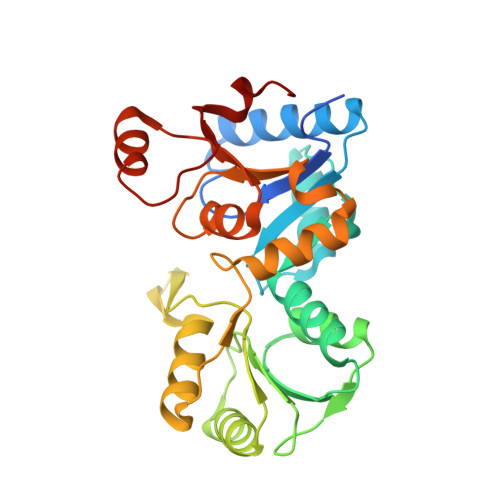Crystal Structure of Thermostable p-nitrophenylphosphatase from Bacillus Stearothermophilus (Bs-TpNPPase)
Guo, Z., Wang, F., Shen, T., Huang, J., Wang, Y., Ji, C.(2014) Protein Pept Lett 21: 483-489
- PubMed: 24256105
- DOI: https://doi.org/10.2174/0929866520666131119200255
- Primary Citation of Related Structures:
4KN8 - PubMed Abstract:
Thermostable p-nitrophenylphosphatase from Bacillus Stearothermophilus (Bs-TpNPPase) is involved in the Mg(2+)-dependent hydrolysis of the phosphoenzyme at an optimum reaction temperature of 55°C. Bs-TpNPPase has been cloned and overexpressed in the E.coli M15 strain. Based on the conserved active sites, the protein was suggested to be a member of the haloalkanoate dehalogenase (HAD) superfamily. Two site-specific point mutants of Bs-TpNPPase were prepared by changing the catalytic Asp10 and Thr43 to Ala10 and Ala43, respectively. The activity of the two mutants further confirms Bs-TpNPPase as a member of the HAD superfamily. HAD superfamily can be divided into the four subfamilies and play several biochemical roles such as DNA repair, signal transduction and secondary metabolism. To understand the relationship between structure and thermostability in HAD superfamily, Bs-TpNPPase from Bacillus Stearothermophilus was selected. The X-ray crystal structure of Bs-TpNPPase was determined at 1.5A resolution using the molecular replacement phasing method. The structure of Bs-TpNPPase has been deposited and the PDB code is 4KN8. Compared with Bsp, a mesophilic prokaryotic putative p-nitrophenyl phosphatase from Bacillus Subtilis, Bs- TpNPPase showed highly homology but variations in the level of leucine content, aromatic clusters, cation-Pi and hydrophobic interaction. These differences may affect the thermal stability of the protein. The crystal structure of Bs-TpNPPase described herein may serve as a guide to better understand the mechanism of thermostability and provide insights for further mutation work.
Organizational Affiliation:
Room 109, Second Biology Building, Fudan University, 220 Handan Road, 200433, Shanghai, China. chnji@fudan.edu.cn.














